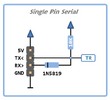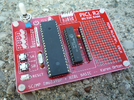OK, we're trying to reverse engineer an expensive lead, to see if we can make a cheaper version. The lead consists of a (fully moulded) FTDI USB plug, which goes to a 'Y' shaped moulded plastic junction 'box', then two leads out to four pin mil. spec. plugs. One of the plugs is male, one is female, and connects to a logger and an optional external battery pack. So you unplug the external battery pack, plug it in to the relevant lead, and then connect the other plug to the logger. The two plugs are simply wired A to A, B to B, etc.
OK, so C is ground, D is presumably power from the battery (but I don't have an external battery pack to test), A is RTS, and B is bi-directional serial data on one pin.
If you plug just the USB plug in, with a terminal program it will echo any keys pressed back to the terminal program.
Without the logger plugged in, pin B is normally high, as soon as the logger is plugged in, it's pulled down low.
It's all run via a custom PC program, and can download all the settings and data from the logger, and upload new settings etc.
So has anyone got any suggestions as how to make the input/output as an FTDI chip work over a single pin? - bearing in mind I've no access to test anything, other than from the USB plug itself, and the two mil. spec. connectors. The lead is far too expensive to destroy, which is what I'd like to do, to examine it more closely.
I've built a 'break out' board, so I can take scope readings etc. and disconnect any of the lines I wish, and I did try adding a schottky diode in the serial connection, but either way round it stops communication taking place.
![IMG_1557[1].JPG IMG_1557[1].JPG](https://www.electro-tech-online.com/attachments/img_1557-1-jpg.142943/)
OK, so C is ground, D is presumably power from the battery (but I don't have an external battery pack to test), A is RTS, and B is bi-directional serial data on one pin.
If you plug just the USB plug in, with a terminal program it will echo any keys pressed back to the terminal program.
Without the logger plugged in, pin B is normally high, as soon as the logger is plugged in, it's pulled down low.
It's all run via a custom PC program, and can download all the settings and data from the logger, and upload new settings etc.
So has anyone got any suggestions as how to make the input/output as an FTDI chip work over a single pin? - bearing in mind I've no access to test anything, other than from the USB plug itself, and the two mil. spec. connectors. The lead is far too expensive to destroy, which is what I'd like to do, to examine it more closely.
I've built a 'break out' board, so I can take scope readings etc. and disconnect any of the lines I wish, and I did try adding a schottky diode in the serial connection, but either way round it stops communication taking place.



